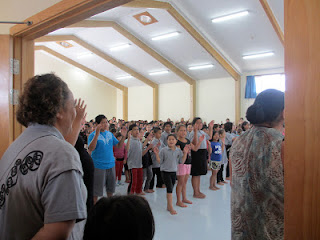Today we were officially welcomed into the country of New
Zealand and into the primary schools by Ranoui Primary School. This welcoming ceremony is called a
powhiri (remember “wh” together makes the “f” sound). This was probably one of the greatest experiences I have had
while being here in New Zealand.
The powhiri a central part of Maori protocol, is a ceremony of welcome
involving speeches, dancing, singing and hongi.
This custom frequently takes place in the workplace to welcome new
staff and important guests, at schools, sports and leisure clubs, and at
significant occasions or ceremonies, such as a building dedication.
Basic
powhiri include the following elements:
The first part is called the Karanga. Immediately when we got onto the grounds of the school we were told to take off our shoes because due to tradition. Then we waited until two young girls started giving us our call of welcome. As they were giving us this call they were holding hands and the other hand that was not being held was shaking. (I’m not sure what this symbolized but I’m sure it means something since all of the women did it when they sang and gave their call.) Then we began to walk slowly into the main room (we weren’t allowed in until a certain time of the ceremony). As soon as we got in the students (learners) began singing for us in Maori welcoming us. This was absolutely darling. The most precious part of the entire thing was when the students all sang the national anthem in Maori and then in English. It almost made me cry it was so amazing. When the whole group stopped singing their was 2 boys that stood and spoke in Maori. It was so cute because you could tell that he was so scared but he did a great job.
You can kind of tell that the students are shaking their hands
This is an actual video from the powhiri of the children singing the national anthem.
The second part is called the Whaikorero. This is where each party
gives a speech in Maori. The male representing the females gives the speech.
Chris, our directors husband gave this speech. His speech followed the form of
a Ko Au Tenei.
Ko________taka Ingoa (my name is…)
Ko________taku maunga (my mountai is…)
Ko________taku Whenua (my land is…)
Ko________taku Moana (my ocean/water is…)
Ko________taku Whenua (my land is…)
Ko________taku Moana (my ocean/water is…)
Ko________taku awa (my river is…)
Ko________taku marae (my home is…)
Ko________taku iwi (my people/family/tribe/ethnicity is…)
Ko________taku waka (my ship/mote of transport is….)
Ko________me________taku Matua (…are my parents)
Ko________taku ingoa (my name is…)
Kia ora koutou katoa (greetings to you all)
Kia ora koutou katoa (greetings to you all)
After Chris gave his speech we participated in the Waiata. This is where the group sings after the male representing them finishes their speech. We sang the song Te Ahora. Here is a video of us practicing our song while we were still taking classes right after we learned it.
Once the song has been sung the Koha takes place. This is where the
dominant female representing the group visiting gives a gift as an expression
of thanks.
The last part of the actual ceremony is where we all did the Hongi.
This is where they physically welcome the visitors. We shook their hands and
then we pressed our foreheads together and our noses touched. This signifies the
jointing together of both groups.
To signify the end of the powhiri there is a meal shared together called the Hakari. We
did this as part of their morning tea. It was so good. There was everything
from chocolates to spinach puffs, to pizza to cream puffs.
This is a picture of all of the principles from the different schools hosting us BYU girls. Rob Taylor (my principle) is the furthest to the right.









How the heck do you always know so much about all the culture stuff?! haha do you look it up when you get home?? I always steal information off your blog haha
ReplyDelete